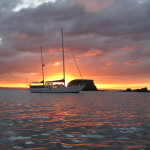
We’ve long understood the value of slow travel, with the benefits of learning a culture, enjoying the less touristed pleasures of a place, meeting local residents and changing a travel plan based on what we find.
On a guided expedition – like the superb 3day/2night Eco-cruz conducted by John Zaeschmar aboard his Manawanui sailboat in the Bay of Islands – that means taking time for lots of activity through which to see and feel the environment you’re exploring. But we found, on this trip in particular, that those who see this area quickly miss the deeper pleasure of taking time to do nothing as well.
Time to Be Very, Very Active
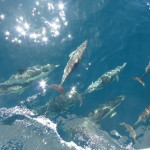
Our trip began with lots to see close to Paihia, the starting point. These are the delights that the half-day and full-day tourist boats have time to do. Within a few minutes, we were busy with the much touted dolphin sightings, though our activity was limited to crossing the deck from side to side and snapping pictures gleefully. Along with the other five passengers, we leaned out over the rail to watch playful bottlenose dolphins in one area and common dolphins in another, as they glided around us drawn by our wake. Dozens, or hundreds together…we could not tell.
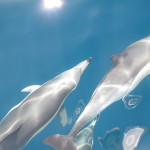
Yet boat captains must know where head to be among them. The trick is to notice the flocks of gannets gathered over the water. When the dolphins feed, they drive the fish forward and to the surface where the gannets can dive-bomb them for their food. So, to find the dolphins, follow the gannets. Fortunately, John could see those flocks from far off, way before we could, and head toward them.
Below, dolphins join us for the ride:
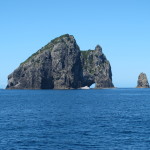
Virtually all the daily tourist boats then take you to end of the elongated southern arm of the Bay of Islands. There, under the watchful eye of the lighthouse at Cape Brett, you can see the Hole in the Rock. This is a barren hump-backed island with an arch on one side, the eponymous hole. As you approach, it looks somewhat like a woolly mammoth lying in the water that it is also sucking up through its trunk. You can see ocean on the other side of the arch or motor through it if you’re the right size.
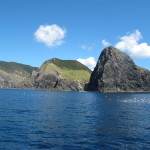
While there, the boats ease along the Cape Brett shoreline, a set of pyramidal islands and green hills, one of which is topped by a gleaming white lighthouse. We were the only ones, however, with the time to see that world from the top.
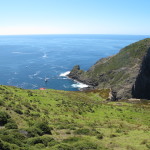
On the way up, we chatted and joked for 20 minutes with a hiking group of Kiwi co-workers who had trekked six hours to stay at the backpackers’ hut just above the slippery landing point. We traded stories and beverages, then climbed up to the lighthouse nearly 150 meters (500 feet) above sea level. The inlets and nooks of the bay stood out deepest blue against the slate-gray pyramids and the bright green hillside. Our now diminutive boat shared the waters with but one other that we could see. We rejoined it about 90 minutes after we had left, and, in the solitude of the cove, repeatedly dived into the cooling sea.
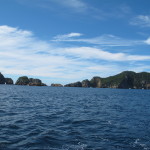
Then we were headed where these boats cannot go in a day, to Poor Knights Islands, one of the top marine reserves in the world about 30 kilometers southeast of Cape Brett. Dive boats do speed out here for a day, but we had a great advantage over them.
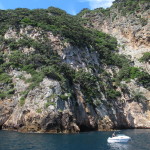
We arrived at dusk and spent the night bobbing at the base of a rocky wall on one of these islands. So we could explore the reefs and coves by ourselves, long before others had arrived bringing noise, cannonball diving and bustle into the sea, other than the fish. These were cold waters, particularly in the morning, and required wetsuits, but our activity – and then the rising sun – kept us warm.
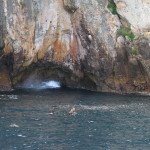
The area was indeed extraordinary. Immediately after we entered the water, we were surrounded by schools of trevally and blue maumau, numbering in the hundreds. John could spot them skimming at the surface, and we soon learned to find them churning it up as well. We were able to approach low-lying caves that turned into blowholes shooting us back out.
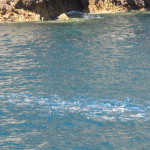
Best of all, we scrambled into and out of our motorized raft at a number of outcroppings and odd rock shapes amid the islands. At one spot, we were swept by a swift current like pinballs through a snaking channel of sharp rock. That rush cut through a tiny island, which we then glided around, admiring a wide assortment of fish like the kingfish, demoiselle, marblefish, wrasses, pigfish, moki and goatfish.
At another spot, currents pulled us into a narrow channel where we hovered over a bluish canyon beneath us filled with more fish. A short ride away, we entered a water-filled bowl where other fish squatted or darted by the dancing seaweed and algae.
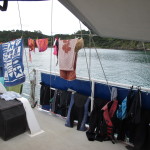
After hours of this activity, we found too many of those diving boats had joined us in our cove, so we pulled up anchor and left them to their own enjoyment. It saddened us that, aside from divers, so few visitors get to see the spectacle of the underwater world here at Poor Knights.
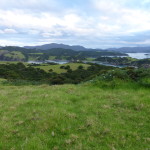
By mid-day, we had started back to the main islands of the bay, harboring in a cove on the western side of Waewaetorea, or Roberton Island. In evening light, we did a second hike for a full circle panorama over the bay, with islands and coves sprawled outward in every direction.
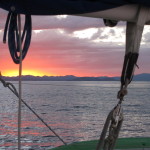
Beneath us the boat gleamed alone in the bronzing twilight while we lounged above in the cushy grasses atop the hill, trying to savor the vista.
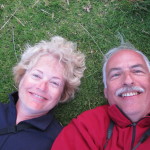
But that’s not all we had time for. When we awoke, we set out on our host’s citrus-colored kayaks toward the northern side of the island. For an hour or so, we wandered inside narrow coves around the rough edges of the shoreline, pushed a bit by the wind-tossed waves, steering around eddies and light breakers. Some of our group headed back to the boat in the cove. But we had relished our opportunity to paddle here, so together with one other we kept going round the island for another hour.
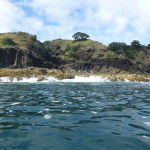
To access the long southern side, we passed through a narrow strait separating our island from the next, a strait churned up by the conflicting currents and by a large tour boat hustling through. Once on the far side of the island, protected from wind and currents, all was placid, as if we were on a lake. The morning sun shone on the adjacent island, Urupukapuka. Along the lengthy straight coastline, the shaded side of our island rose straight up to a forested summit. Oystercatchers squawked to chase a passing hawk. As we rounded the island’s narrow west end and the mast of our sailboat peeked over the rocks, we were sorry to be back.
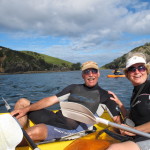
Yet we were soon back in the water, this time to catch mussels. Since these affix themselves to rocks, we didn’t have to chase them down of course. But the prime spot was on a rocky mound with knife-sharp crevices underwater and a swirling eddy around it. The hardy among us free-dove a few meters down to snatch the huge green-lipped mussels, twist and pull them from their nesting spot while avoiding collisions with the serrated rock, and then bring them up. The three dozen mussels our group collected in this way, once sauted and barbecued, made a grand feast a few hours later.
It was time to ease our way back, but not before we had one other thrill. Along the way, we tracked a solitary Brydie’s whale for a while, together with a handful of fishing boats. We didn’t see much of him, as he was sleek and just marked by a dolphin-like fin on top, though he seemed to pass beneath us at one point. Nor did we spy any other whales, since it was not the ideal season for them. But the sighting demonstrated what extra time on the water makes possible. Touristy in-season whale watching trips deploy spotters and aircraft so they can ensure you see whales in a concentrated period of time. Natural events, like our sighting of the Brydie’s whale, mostly occur on their own time.
Time to Do Nothing
All this activity made our sailboat cruise immensely satisfying and enjoyable. What made it special was the time we had to do nothing.
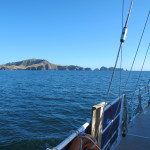
The first day, it took perhaps four hours to reach the Poor Knights Islands, with little wind to sail by and under slow engine power. It was a time of little activity. Instead, we idled on the sunny deck in easygoing conversation with our fellow passengers, eyeing the wide expanse of ocean in all directions. That night, at anchor, we lounged on deck, watching Orion and the stars of the Milky Way slowly punching holes in the dark, dark sky. And we followed the progress of the crescent moon matched by its watery reflection. The mast swung back and forth as we rocked with the waves, lulling us into pleasure and then into sleep.
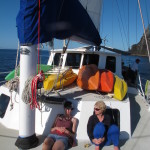
On the long return trip from our busy day at Poor Knights, we could just relax, filling our minds with the ocean and islands as they slipped by. That night, as we sat and talked, clouds covered the sky. Almost unwittingly, we whispered on deck. The protected cove and the boat had become so still that any noise seemed loud.
Our meals proceeded slowly and enjoyably as well, centered around the tuna (as sushi, ceviche, or broiled) and kahawai (smoked) we had caught along the way, as well as the mussels on the barbie. With John’s gourmet cooking skills, we had the taste of the Bay of Islands in our mouths.
It’s easy to think that the measure of a trip comes from all the things that you see and do. Certainly, taking a longer time, as with the three days of our sailboat cruise on the Manawanui, lets you, say, dive into more and more energetic activities.
But in a shorter span of time we would have missed even more than activity. We would have missed the indolent time between activities, the space we could find for the incomparable values of stillness, peace and nothingness.
(Also, for more pictures from New Zealand, CLICK HERE to view the slideshow at the end of the New Zealand itinerary page.)


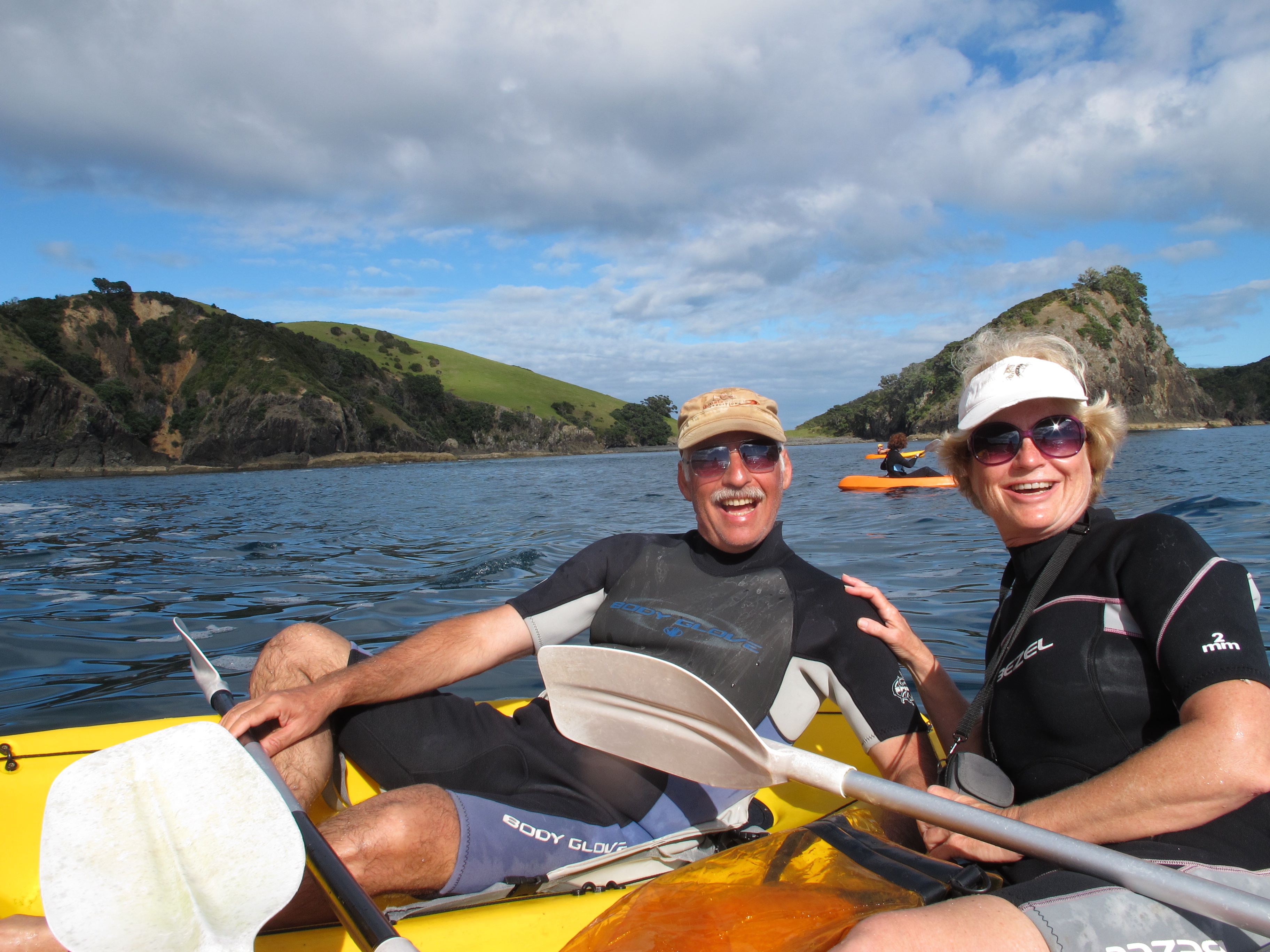
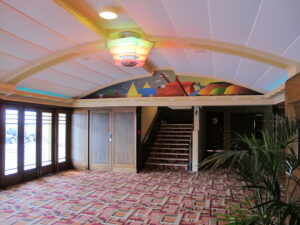
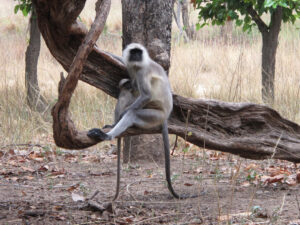
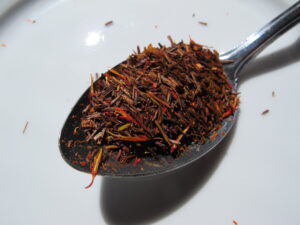
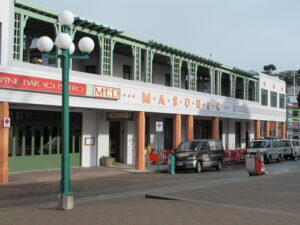
Dear Nancy and Barry,
Thank you for the great synopsis of our Bay Island cruise! I feel like I did not miss a
thing!!!!!!!!! I am enjoying all of your posts.
Safe travels,
Mary Beth